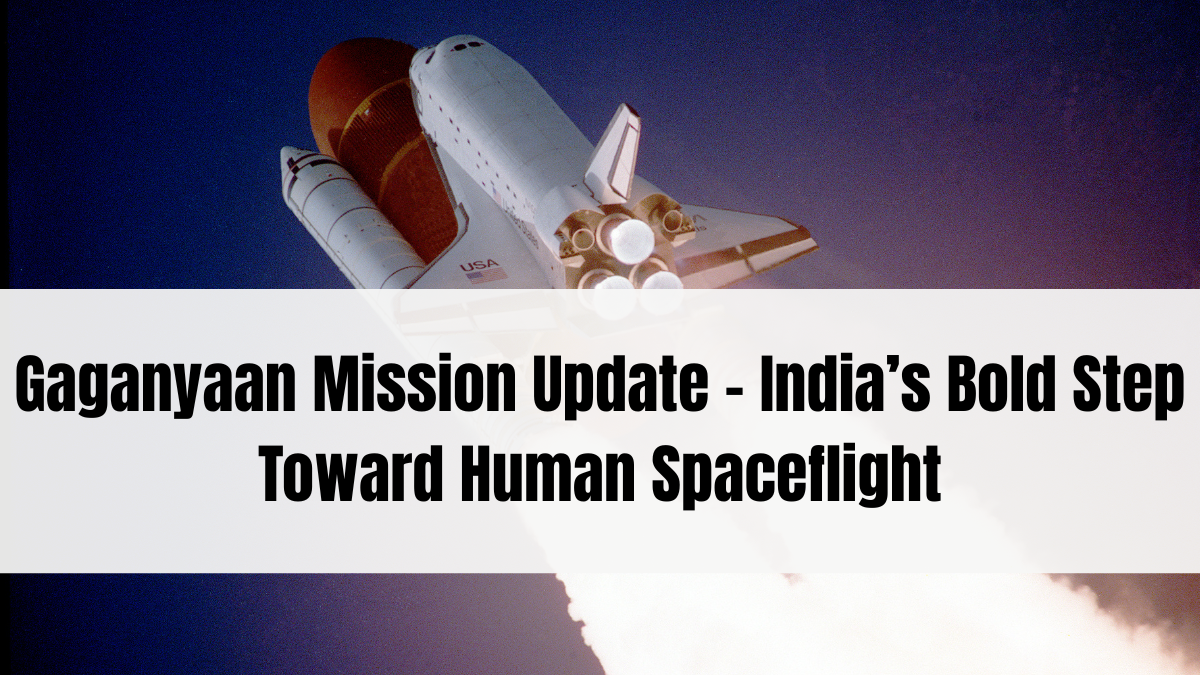India’s space ambitions have entered a historic phase with the ISRO Gaganyaan Mission Update for 2025. Gaganyaan is India’s first crewed spaceflight program, placing the country among an elite club of nations capable of sending humans into space using indigenous technology. The mission not only showcases ISRO’s engineering excellence but also reinforces India’s commitment to space exploration and innovation.

Table of Contents
What Is the Gaganyaan Mission?

Gaganyaan is a high-priority space mission launched by ISRO to demonstrate human spaceflight capability. It plans to send a three-member crew into Low Earth Orbit (LEO) for up to 3 days and return them safely back to Earth.
The spacecraft will be launched using ISRO’s trusted GSLV Mk III rocket, also known as LVM-3.
Key Objectives of Gaganyaan:
-
Test India’s life-support systems and crew safety mechanisms.
-
Develop recovery, emergency escape, and re-entry technologies.
-
Create a sustainable roadmap for future manned missions.
Gaganyaan Mission Timeline 2025
Gaganyaan’s preparation spans multiple test phases. As of 2025, the mission has passed several major milestones:
| Phase | Status (2025) |
|---|---|
| Unmanned Test Flight 1 | Completed successfully |
| Test of Crew Escape System | Validated in all stages |
| Astronaut Training in Russia | Finished in 2023 |
| Indian Gaganyaan Training Hub | Operational in Bengaluru |
| Crewed Mission (3 astronauts) | Scheduled for end of 2025 |
India is set to become the fourth country after the US, Russia, and China to achieve independent human spaceflight.
Technologies Behind ISRO’s Human Spaceflight
The ISRO Gaganyaan Mission Update highlights several homegrown technologies:
-
Crew Module: Pressurized space capsule for 3 astronauts.
-
Service Module: Contains propulsion and life-support systems.
-
Environmental Control System: Maintains cabin pressure, oxygen, and temperature.
-
Emergency Escape System: Pulls crew to safety in case of launch failure.
-
Mission Control Interface: Advanced ground communication and telemetry systems.
All systems are being developed or coordinated by ISRO, DRDO, and Indian aerospace contractors.
Astronaut Training and Safety Measures
Four Indian Air Force pilots were selected for intensive astronaut training. Their preparation includes:
-
Zero-gravity simulation
-
Survival training in deserts and jungles
-
G-force exposure chambers
-
Parabolic flight training for weightlessness
-
Simulator sessions in Bengaluru’s Human Space Flight Centre (HSFC)
These steps ensure the ISRO Gaganyaan Mission Update keeps crew health and safety at the forefront.
Gaganyaan’s Impact on India’s Space Future
India’s crewed mission is just the beginning of long-term ambitions:
-
Building indigenous space stations by 2030
-
Conducting space-based biological experiments
-
Developing long-duration space habitats
-
Participating in international missions through collaboration
The success of Gaganyaan will elevate India’s standing in the global space sector and open up new avenues for scientific research and private sector participation.
FAQs
What is Gaganyaan’s main goal?
To demonstrate India’s capability in launching and safely returning astronauts from space using indigenous technology.
How many astronauts will go aboard the Gaganyaan mission?
Three astronauts will be part of the first crewed flight, expected by the end of 2025.
Is the Gaganyaan crew already selected?
Yes, four Indian Air Force pilots have undergone extensive training, and three will be selected for the mission.
What rocket is used for Gaganyaan?
The mission will launch using the GSLV Mk III (also known as LVM-3), ISRO’s heavy-lift launch vehicle.
Will Gaganyaan orbit the Moon?
No, the current mission is aimed at Low Earth Orbit (LEO) only, for a duration of 3 days.
Click here to know more.






